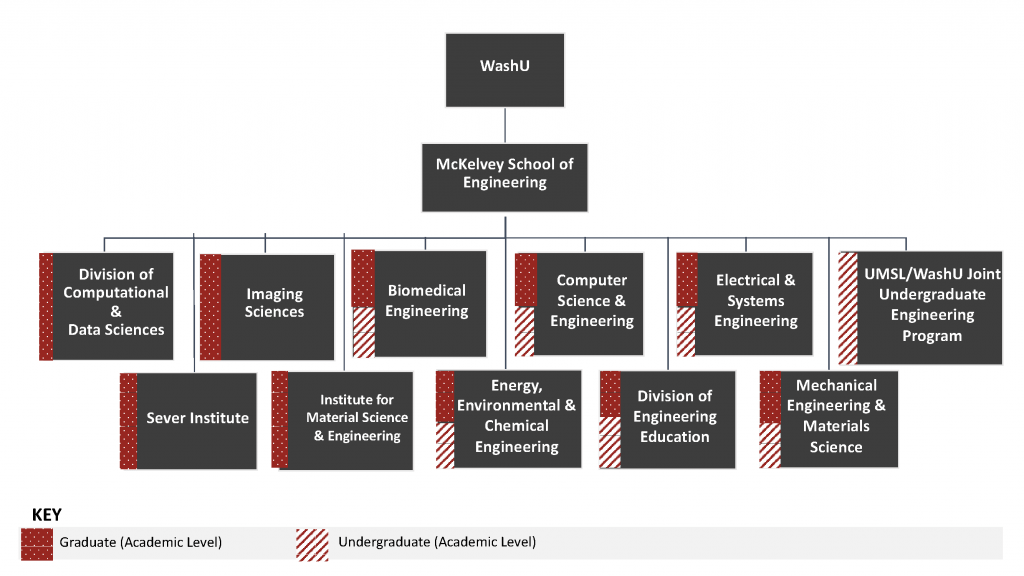Key Idea
Academic units are the primary organizational structure in Workday Student. They are used to represent schools, divisions or any other unit that admits students, offers programs of study or offers courses. Academic units are structured together to manage academic process flows, security access, Workday rule inheritance and reporting.
Jump To: Academic unit structure | Academic levels | Academic units vs. supervisory organizations | Academic divisions as academic units
Academic units overview
Workday is built on a network of structures that streamlines sequences of tasks (also called business processes or workflow routing) and facilitates reporting at both a summary and detailed level. Academic units are the primary organizational structure in Workday Student, akin to supervisory organizations (sup orgs) for Workday HCM and the foundation data model (FDM) in Workday Finance.
Academic units (AUs) are used in Workday to represent schools, departments or any other unit that admits students, offers programs of study or offers courses. Academic units in Workday also hold a faculty member’s academic appointment, which is different from their position.
This recording provides an overview of academic units.
Academic unit structure
Within Workday, related academic units are organized together to form the academic unit structure. The academic unit structure:
- Determines process/workflow routing for student tasks and transactions, like tuition payments or course registration
- Drives security access, like who can view advising notes
- Determines which Workday rules – like academic calendars, grading policies and student payment types – apply to which academic units
Similar to supervisory organizations in Workday HCM, academic units can be designated as “superior” or “subordinate” to one another to form tiered relationships. Within the academic unit structure, Workday rules assigned to a superior academic unit are inherited by some or all of the academic units below it in the structure, depending on the rule.
There will be a single academic unit structure for WashU when we go live with Workday Student. Meaning multiple academic unit structures cannot exist in Workday, and that is why collaboration and communication between schools, HR and the Student Sunrise project team are essential to ensure academic units are configured correctly in Workday.
Academic levels
Academic units, paired together with academic levels, are comparable to how we use divisions today. WashU has two academic levels: graduate and undergraduate.
We can configure Workday to follow specific rules for each academic level within an academic unit. For example, the Performing Arts academic unit can be designed so that certain programs of study and grading policies apply only to undergraduate students and not to graduate students. Similarly, security can be assigned so that an administrator has access to only graduate student data and not undergraduate. This eliminates the need for separate academic units for those two student populations.

Academic divisions as academic units
Most academic divisions will translate to academic units, which are used in Workday to represent WashU’s schools or any other unit that admits students and offers programs of study or courses. WashU also has two academic levels in Workday: graduate and undergraduate. We can configure Workday to apply different policies to the graduate academic level than the undergraduate level within a given academic unit.
Today, a school might have different academic divisions representing undergraduate and graduate programs within the same school. For example, the Sam Fox School has both an academic division for the undergraduate programs in Art (abbreviated FA) and a separate academic division for the graduate programs in Art (abbreviated GF). In Workday, these two divisions will be represented by a single academic unit (College of Art) with two academic levels (graduate and undergraduate).
Academic units vs. supervisory organizations
Both academic units and supervisory organizations are foundational to Workday and drive workflows, security and other rules. However, there are some key differences.
The most important is that academic units house academic functions, while supervisory organizations group workers into a management hierarchy. This means that, unlike supervisory organizations, the academic unit structure is not intended to reflect how people report to each other.
| Academic Unit | Supervisory Organization (Sup Org) |
| Houses foundational academic functions (programs of study, courses, student enrollment, etc.) | Groups workers into management hierarchy |
| Determines workflow for student transactions (e.g., tuition, admissions, registration, financial aid) | Determines workflow for HR-related transactions (e.g., time approval, hire) |
| Examples include schools and divisions | Examples include business offices and administrative departments |
Academic unit FAQ
*Last updated 05/23/22